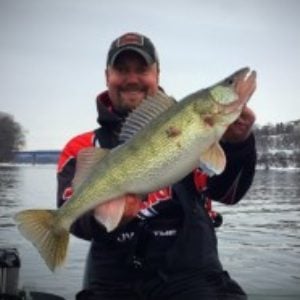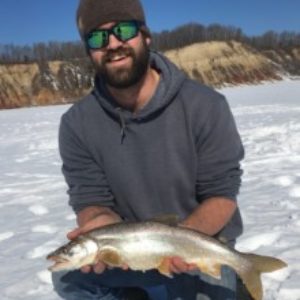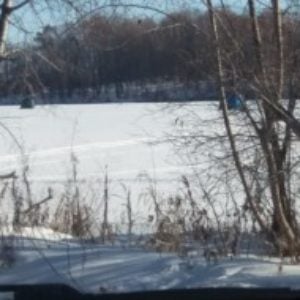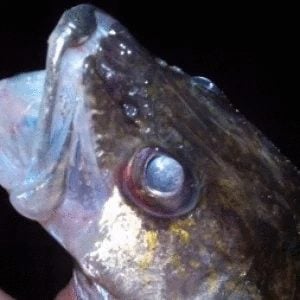im curious about identifying fish patterns. Lately ive been reading up on ice fishing patterns, i.e. early ice pattern, mid winter pattern, and how that relates to where walleye are located. What ive found thus far is that people say early ice walleye will be located in water as shallow as 5 or 6 feet up to maybe 15 or 18 ft off of weedlines, sharp breaks, points ext. Come mid winter season they will move deeper and go to mid lake humps and can be found in water anywhere from 25-50ft deep. My question is that with this winter being very abnormal and being unseasonably warm what pattern are walleye in now? Last year early ice started in the 2nd week of November and this year there are people that still haven’t ventured out and its almost the 2nd week of January. What triggers fish location in wintertime? Im sure there are a lot of factors that go into it but us humans tend to think of the patterns in terms of ice conditions and time of year whereas I would guess the fish doesn’t really care that much about what date it is or how thick the ice is.
IDO » Forums » Fishing Forums » Ice Fishing Forum » Fish Patterns (walleye)
Fish Patterns (walleye)
-
 Tom SawvellInactivePosts: 9559January 6, 2016 at 8:32 am #1590148
Tom SawvellInactivePosts: 9559January 6, 2016 at 8:32 am #1590148Lots of factors to think about with your question but I think a person has to understand how food will be one of the biggest factors. The food chain during the winter months may not be so easy to figure out for some fish because what the predator fish eat, fish like the walleyes, larger crappies, pike, can be dependent on a bug/micro organism related base that is turned on and off by things like low light periods and/or water temperature and bottom content.
Water clarity can steer the fish. Moon phase can steer the fish. Hormonal changes can steer the fish. But I still think food is the key driver. And therein lies the search issue….walleyes, crappies, pike….all will travel outside of their comfort zone where they can be marked while at rest but not hitting. Figure out where the predator’s food is at and what conditions are needed to support that forage and at some point during a 24 hour span you will hit the jackpot.
January 6, 2016 at 9:14 am #1590160James did make a good point in the most resent show, fish the conditions and not the calendar. It is still fairly early ice conditions and my outings so far this season have been starting in early ice spots with pretty good results but as Tom noted there are quite a few factors to consider that could drive fish movement day to day.
 Matt Quick
Posts: 17January 6, 2016 at 9:22 am #1590159
Matt Quick
Posts: 17January 6, 2016 at 9:22 am #1590159crappie 55369 this is a question we are trying to figure out right now also. We were out the last two days and searching hard with little success.
The question on patterns is interesting as I feel the lakes forage base and structure play a large role with that, I don’t think we can apply any real strategy across the board.
In respect to many lakes in MN I feel that they def. move into the shallows in the fall too the shallower rock/weed structures and remain there until the water temps stabilize when the winter months take hold. As this happens they will push out to the first main lake structures such as flats, points and breaks, this at times may not last that long.
I always tend in the winter to start out in the later spots as I feel you can pretty much find fish in all areas most of the time and it gives me IMO a good opportunity to take the mood of the fish and adjust from there. This way of searching generally gives you more obvious options also as shallow breaks and weed lines can at times be intimidating as the amount of fishable areas is 10X that of the first breaks, points and humps. One piece to this puzzle we must remember is that in “early ice” situations we still have a fairly robust weed base which will continue to provide oxygen and a food source for our panfish which in turn will hold our predatory fish such as walleye, northern and bass to name a few. As the “season” progresses and we get snow cover the light is not able to penetrate and sustain a solid weed growth and will push out the smaller fish to main lake basins and points. This will undoubtedly draw the walleyes with as the food moves so do they.
As I said, over the last two days we started each morning in 24 FOW just off the end of main lake points and didn’t have much success. We began searching off the edge into 28-40FOW and found a few walleyes but not in the size class we wanted (10-14in) we then drilled all the way into 8 FOW to the edge of the weed line with little to no marks or fish to be had.
I am under the impression that at least where we have been fishing (N. Metro) the weather has been playing a large role in the negative mood of the fish. We found many fish that would chase but getting them to commit to bite was a real task. This is contrary to normally what we have seen in the same spot/ same time of year so again, weather patterns as of late in this area I believe has played the largest role.
This is what I find so fun about fishing. You can attack this problem with so many different points of view the only common denominator is whether or not you’re out there trying to figure the puzzle out.January 11, 2020 at 10:25 pm #1905532Its always amusing to me when I search a topic on the internet and click on a link that seems to be talking about exactly what I want to read about only to find it’s a thread i started years ago lol. Happens more than you would think.
Still a topic of interest me- identifying where to target walleye. I’ve been targeting 15-20 ft lately. I’m thinking they may be moving deeper. Plan on checking out some mid lake humps more in the 30-35 ft range next week.
January 12, 2020 at 7:34 am #1905555Seems like the people that are willing to move regularly catch more walleyes and fish in general. The wheel houses that sit there for extended periods of time often fish over dead water until fish happen to show up. Just an observation.
January 12, 2020 at 7:45 am #1905556Seems like the people that are willing to move regularly catch more <em class=”ido-tag-em”>walleyes and fish in general. The wheel houses that sit there for extended periods of time often fish over dead water until fish happen to show up. Just an observation.
Agree
January 12, 2020 at 7:47 pm #1905695I would agree also other factors to consider is fishing pressure and fishing in higher % spots
January 12, 2020 at 8:48 pm #1905706Whole lotta variables but I would focus on these:
1) long term weather…..just like in the summer when it gets real hot the fish push deep when it’s been cold for an extended period of time.
2) water clarity….either due to stained water or snow cover on the ice. Darker the water or low light penetration and fish will be shallower.
3) forage….where and when are the bait fish moving?
Not sure how mobile you can be but I start shallow or deep and work the opposite way until I find fish. Always find points, weed lines or breaks and start my search on or adjacent to them.
Also, I use tip ups a lot. If you want to start deep, set a tip up shallow or vice versa.
January 12, 2020 at 10:00 pm #1905732here is what I think goes on. early ice, which may be into February this year for some, the bigger/smarter walleyes spend most of their time in shallower waters(5-12′). the smaller ones are still in the deeper areas because they are afraid of being eaten by larger predators which hunt in shallow water(born instinct). not really breaking any new theories here but the bigger eyes who are not afraid of being hunted, do their grocery shopping in the shallower areas of lakes. I have friends who spear and can validate that there are big eyes cruising shallows. with the drastic climate changes in recent years, be prepared to fish in areas normally not fished. try not to over think it and just go fishing. a lot of lakes I fish have limited structure and the fish just cruise looking for food, so why move when they will come to you. a lot of lakes with structure and fish not there tells me to look shallow vs deep.
 Alex Roers
Posts: 43January 13, 2020 at 8:42 am #1905776
Alex Roers
Posts: 43January 13, 2020 at 8:42 am #1905776We’ve done all of our walleye fishing on a southern MN lake so far this year. Its part of a river system so it has a channel through the lake that ranges from 20 to 50 feet and this is where most people fish. We haven’t fished deeper than 8 feet yet this year and have been catching 2-4 keepers a night. We’ll stay in this 5-8 foot range until the ice thickens and forces the fish and us out to deeper stucture.
 iTinker
Posts: 181January 13, 2020 at 10:07 am #1905810
iTinker
Posts: 181January 13, 2020 at 10:07 am #1905810What features do most people look for on new bodies of water when looking for healthy submerged vegetation? Is it just punch and check from 9-11′ near emergent vegetation?
January 13, 2020 at 10:55 am #1905825Patterns Smatterns….
Yesterday’s way-points often a waste of time today.Game we play always the same.
Find the fish, Fish the fish.The only shortcut to knowing where the fish are is if you found them yesterday and they happen to be there again today.
Education happens after playing the game many times and winning. Winning might be finding the fish, might be finding where your not finding fish. Always take home a lesson.With time comes educated guesses. This still never super-seeds finding the fish every time.
January 14, 2020 at 8:51 am #1906109I’m far from any type of authority, but I think most of the answers are here. It depends on forage, clarity and structure.
In clear lakes like Mille Lacs last week the day bite was around 32ft! I’d look for boulder/gravel structure, humps if possible and transition areas.
I like the funnel approach where they can feed deep at their leisure during the day and come higher up the structure during early/late periods.
 Deuces
Posts: 5349January 14, 2020 at 9:20 am #1906113
Deuces
Posts: 5349January 14, 2020 at 9:20 am #1906113Northern sconnie my uncle continually catches small to big walleyes under clear ice in gin clear spring fed waters on sunny days in less than 4′ water, sometimes that’s with the ice. That sun angle is nothing nowadays, remember how shallow fish are in spring and fall. He always used setlines or tipups, so the noise factor should be considered.
I’ve seen it firsthand and will blow any of these theories out the door.
January 14, 2020 at 9:27 am #1906114In clear lakes like Mille Lacs last week the day bite was around 32ft!
The science and biology behind walleye behavior indicate they are actually nocturnal. They prefer darker water. Their large eyes are very sensitive to sunlight. Which is why on a bright sunny day, they will often be deeper than on a cloudy or windy day. Plus the water in Mille Lacs has greatly cleared up over the years which could be a big factor as to why the population may not be what it once was. That is another topic for another day though…
February 5, 2024 at 6:15 pm #2252174Funny. With the warm weather I’ve been thinking about how to identify walleye patterns. I almost created a post about it but figured I would ask jeeves first. One of the first things that pops up is my own post with the same question lol. Guess I haven’t learned much over the years. Figures
February 6, 2024 at 6:28 am #2252227Some times you think you have it dialed. Only to try again and come out with a head scratcher. I think fbrm post is pretty spot on.
You must be logged in to reply to this topic.
